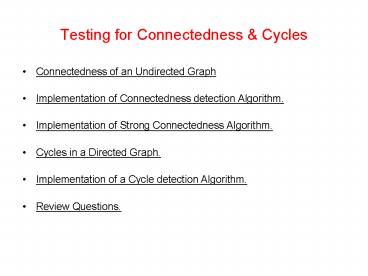Testing for Connectedness - PowerPoint PPT Presentation
Title:
Testing for Connectedness
Description:
Using the CountingVisitor, the isConnected method is implemented as follows: ... { 2 CountingVisitor visitor = new CountingVisitor(); 3 breadthFirstTraversal ... – PowerPoint PPT presentation
Number of Views:58
Avg rating:3.0/5.0
Title: Testing for Connectedness
1
Testing for Connectedness Cycles
- Connectedness of an Undirected Graph
- Implementation of Connectedness detection
Algorithm. - Implementation of Strong Connectedness Algorithm.
- Cycles in a Directed Graph.
- Implementation of a Cycle detection Algorithm.
- Review Questions.
2
Connectedness of an Undirected Graph
- An undirected graph G (V, E) is connected if
there is a path between every pair of vertices. - Although the figure below appears to be two
graphs, it is actually a single graph. - Clearly, G is not connected. e.g. no path between
A and D. - G consists of two unconnected parts, each of
which is a connected sub-graph --- connected
components.
3
Implementation of Connectedness Algorithm
- A simple way to test for connectedness is to use
either depth-first or breadth-first traversal -
Only if all the vertices are visited is the graph
connected.
1 public class CountingVisitor extends
AbstractVisitor 2 protected int count 3
public void visit (Object obj) 4
count 5 6 public int getCount
() 7 return count 8 9
- Using the CountingVisitor, the isConnected method
is implemented as follows
1 public boolean isConnected 2
CountingVisitor visitor new CountingVisitor()
3 breadthFirstTraversal (visitor, 0) 4
return visitor.getCount() numberOfVertices 5
4
Connectedness of a Directed Graph
- A directed graph G (V, E) is strongly connected
if there is a directed path between every pair of
vertices. - Is the directed graph below connected?
- G is not strongly connected. No path between any
of the vertices in D, E, F - However, G is weakly connected since the
underlying undirected graph is connected.
5
Implementation of Strong Connectedness Algorithm
- A simple way to test for strong connectedness is
to use V traversals - The graph is strongly
connected if all the vertices are visited in each
traversal.
1 public boolean isStronglyConnected () 2
for (int v 0 v lt numberOfVertices v) 3
CounteingVisitor visitor new
CountingVisitor() 4 breadthFirstTravers
al (visitor, v) 5 If
(visitor.getCount() ! numberOfVertices) 6
return false 7 8 return true 9
6
Cycles in a Directed Graph
- An easy way to detect the presence of cycles in a
directed graph is to attempt a topological order
traversal. - This algorithm visits all the vertices of a
directed graph if the graph has no cycles. - In the following graph, after A is visited and
removed, all the remaining vertices have
in-degree of one. - Thus, a topological order traversal cannot
complete. This is because of the presence of the
cycle B, C, D, B.
7
Implementation of a Cycle detection Algorithm
- The following implementation uses a visitor to
count the number of vertices visited in a
topologicalOrderTraversal.
1 public boolean isCyclic() 2
CountingVisitor visitor new CountingVisitor() 3
topologicalOrderTraversal (visitor) 4
return visitor.getCount() ! numberOfVertices 5
8
Review Questions
- 1. Every tree is a directed, acyclic graph
(DAG), but there exist DAGs that are not trees. - a) How can we tell whether a given DAG is a
tree? - b) Devise an algorithm to test whether a given
DAG is a tree. - 2. Consider an acyclic, connected, undirected
graph G that has n vertices. How many edges does
G have? - 3. In general, an undirected graph contains
one or more connected components. - a) Devise an algorithm that counts the number
of connected components in a graph. - b) Devise an algorithm that labels the vertices
of a graph in such a way that all the vertices in
a given connected component get the same label
and vertices in different connected components
get different labels. - 4. Devise an algorithm that takes as input a
graph, and a pair of vertices, v and w, and
determines whether w is reachable from v.

